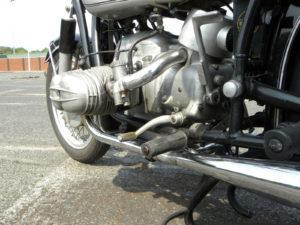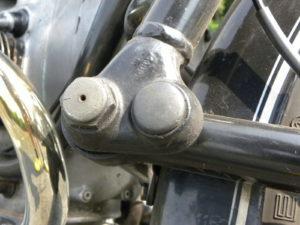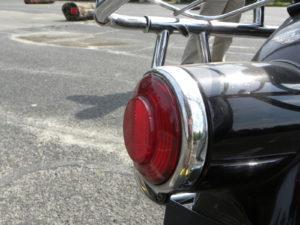Before Honda invented new motorcycling, there was only one heavy, fast, reliable motorcycle: the 594 cc BMW R69S. With a seated rider the R69S was running 150 + km \ u. He did not leak oil or explode. That was exceptional at the time
The BMW 'Vollschwingen' models with their characteristic Earless rocking arm front fork were definitive quality products. Globally, the expensive BMWs were not seebought. They became gebought. That the R69S was the fastest series-built motorcycle, that did not make him a sport motorcycle. With (leather) bags or highly modern polyester suitcases, it became such BMW a touring motor. A sport motor with a lower handlebar.
In early R69s, a crankshaft or cylinder sometimes broke off due to vibrations
That is why the crankshaft of the R69S in 1963 on the front crankshaft stump was equipped with a torsion / vibration damper. The modification can be seen on the 'hump' on the front of the crankcase. That bump required a slight flattening of the lower rear arch of the Earless fork. The R69S is also recognizable by the slightly wider valve covers with only two longitudinal ribs. Another feature is that the exhaust bends run from the heads 'inwards' instead of rather directly backwards. The detailed exhaust bend line provided just a little more ground clearance in the bends. The exhaust pipes of an R69S are also a fraction thicker than those of the R50 and R60.
Driving a BMW R69S
What strikes you first: the topper of the time is a slim, low motorcycle. The BMW starts 'across'. After shocking the Bing carburettors, the engine starts after the second stage with its characteristic 'hollow' growl. The choke can quickly come off. The flat - almost - 600 cc twin is content to shake in the frame. The switching of the left-hand gearbox is done with a clear 'Klak'. The rear of the machine will lift slightly when the clutch is released. The cardan shaft is drawn so 'slim' that it actually worked as a torsion bar and made the rigid transmission smoother. The four-speed gearbox works well when the rider is not in a hurry. Before the clutch is operated, some pressure is built up on the gear pedal and then gently upshifts. The BMW R69S is a fast, but not nervous machine.
The design with the middle, high in the block camshaft ensures a valve control too much mass to really enjoy high revs. But the R69S would like to be driven a little higher. That also makes it less suitable as a sidecar tractor. Even when cornering, the BMW is not very temperamental. He would like to be sent in emphatically, but the stable bicycle part allows him to follow the chosen lines. The beautiful full brake hubs were just good at the time, but are still poor in the current traffic.
The double cradle frame with side oval-drawn front legs is a model of Teutonic engineering
To the beautiful aluminum 2.15 B x 18 rims belong 3.50 x 18 tires. The full hub drum brakes are Ø 200 mm (the front brake has two ascending shoes). The tank capacity is 17, optional 24 liters and with a full 17 liter tank the machine weighs 195 kilos. The fuel consumption of an R69S was on average 1 on 18,5.
And an R69S as a sidecar tractor? That was actually not a good idea. The R69S is a trotter, not a lug
Thanks to Theo Terwel, Vorden












